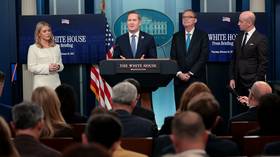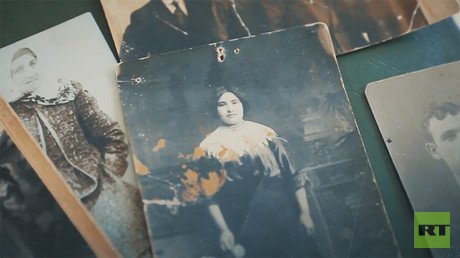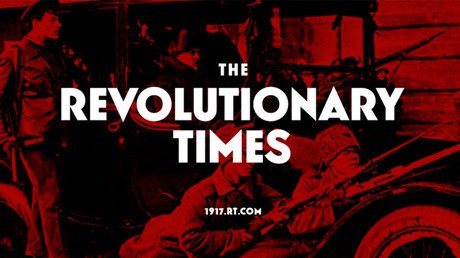#1917LIVE finale: RT’s Russian Revolution role play ends December 31

275,000 tweets, 75 million impressions and some 250,000 followers across accounts. As the #1917LIVE re-enactment of the Russian Revolution draws to a close, RT looks back on the stories that have made it such a special endeavor.
The #1917LIVE project covered the breadth of events surrounding the revolution and the state of the world as a whole, which was in the throes of the Great War – the bloodiest conflict history had ever known. A great number of historical personae from the Russian, French, German, American, British and other contingents of the period were used. Many of these were prominent guest authors such as Paulo Coelho and Helen Rappaport, as well as historians from the US and the UK, all part of our #1917CROWD. The project’s followers included notable EU politicians, among them British and Italian MPs, as well as the Spanish ambassador to Russia, the British ambassadors to Estonia and Ukraine, and the Russian Mission to the UN.
Out with the old, in with the new, may all wishes of our followers come true in 1917! Happy New Year and God Save the Tsar! #1917LIVEpic.twitter.com/Bvi4THlero
— Revolutionary Times (@RT_1917) December 31, 2016
The tweet above is from the Revolutionary Times, originally tweeting as the Russian Telegraph – a fictitious newspaper at the center of the #1917LIVE project, reporting on the main goings-on in the capital and on the front line. In November, the newspaper’s office was taken over by the Bolsheviks, who co-opted it for their proletarian agenda. The fictitious publication recorded the daily interactions between the historical figures, as the Bolsheviks and the Provisional Government vied for power in a post-Nicholas Russia.
Bourgeoisie ready to commit most heinous crimes, like organizing drunken disorders and food supply sabotage endangering millions, only to undermine Soviet government pursuing socialist transformations #1917LIVE
— Vladimir Lenin (@VLenin_1917) December 20, 2017
The aim of the project was to bring our audience closer to Russian history in a way that was undiluted by modern narratives, particularly about the period’s key protagonists and their motives. Thorough historical research was carried out to bring the characters of Lenin, Trotsky, Kerensky and Nicholas II to life.
Ukrainian authorities still believe they will enjoy a special role in hypothetical federal government and be given 1/3 of the power #1917LIVEhttps://t.co/W8GupQ3WXa
— Leon Trotsky (@LeoTrotsky_1917) December 20, 2017
RT has tried to give an insight into why the Russian Revolution was an inevitable development. Its aim has been to inspire the audience to learn in an age of Twitter, while at the same time raising social media standards.
READ MORE: Best in Education: RT’s #1917Live project grabs prestigious social media ‘Shortys’ award
The project attracted the attention of media, authors and historians, and was recognized for its contribution to people’s understanding of Russian revolutionary history, snatching 6 nominations at different prestigious awards, receiving 4 prizes. The project has been named "Best In Education" and received Gold in “Best Twitter Presence” at the Shorty Social Good Awards. RT also won 2 bronzes at the Epica Awards in the “Media” and “Online: Social Networks” categories. At the DRUM Social Buzz Awards, #1917LIVE received a “Highly Commended” notice for Most Innovative Use of Social.
To cheer us up and as a way of passing the cold dark winter days our tutor Mr Gibbes has suggested we perform some one-act French plays. Maria and @AlekseiNR_1917 are rehearsing one with Monsieur Gilliard. Tatiana and Anastasia will be in the other one #1917LIVEpic.twitter.com/V9higiAHPV
— The Romanov Sisters (@OTMA_1917) December 17, 2017
The reach of the Twitter re-enactment extended so far that it managed to provoke the ire of the British government for the sin of using the British Embassy handle for one of its characters. Twitter was asked to compel RT to take down the fictitious account that dated back to the Russian Empire - which of course no longer exists.
Journalists at the Guardian, Bloomberg, the Wall Street Journal, the New York Times, the Washington Post, Newsweek, and France 24 were counted among the followers of the #1917LIVE project, while stories about it have been published in more than 10 languages by the Jerusalem Post, La Stampa, CBC, Die Presse, El Pais, Telesur and others.
As the history of the struggle played out – first against the reign of Tsar Nicholas II, then against the bourgeois provisional government – the project bore witness to the lives of many of the period’s other historical characters, thanks in no small part to its guest stars.
Author Paulo Coelho took on the role of the femme fatale and suspected double agent Mata Hari, covering the final days of her life before her execution by a French firing squad.
Brazilian artist Marina Amaral celebrated the anniversary of the Russian Revolution with a painstaking pixel-by-pixel color rendering of its characters and events. She did this by performing thorough historical research and employing her signature technique to breathe new life into the personae of Lenin, Kerensky and the Royal Family.
Author Helen Rappaport played a very important part in bringing to life the vastly under-represented Romanov sisters, often referred to simply by their collective place within the family. “Writing Four Sisters (and I chose that title as a deliberate reference to Chekhov’s Three Sisters) was a very special experience for me because I became so absorbed in the lives of those four tragic young women. I wanted passionately to tell their story and give them back their own individual identities,” Rappaport told RT. “Too often in the past they have been pushed into the background as an anonymous collective that they weren’t. They were so very different and each had their strengths and weaknesses,” the author explained.
#Anastasia I took this picture on my @Kodak Brownie in the mirror, and it was hard because my hands shook #WorldPhotoDay#1917LIVEpic.twitter.com/m9wrIHjDY6
— The Romanov Sisters (@OTMA_1917) August 19, 2017
The character of the Royals’ favorite artist – chemist and photographer, Sergey Prokidin-Gorsky – was portrayed by Bosnian artist Aleksandra Lopatic. The Paris-based artist says she strongly identifies with the pioneer of color photography, whose life’s work was to document the lives of the Royal Family. “This experience gave me an important lesson: being submerged for six months in the interaction with the audience of another artist than me, I realized that what unites us all on the planet is our humility before the beauty of our world,” she told RT.
November witnessed the project’s culmination, as Russia marked the 100-year anniversary of the 1917 Revolution. Now the Bolsheviks are busy defeating the last pockets of resistance – a process that will last for some time.
















